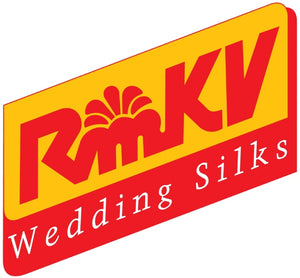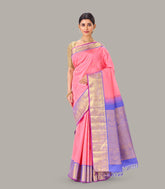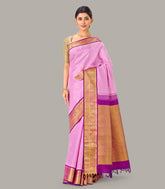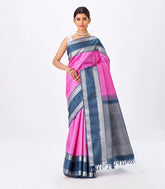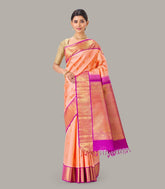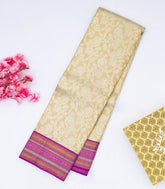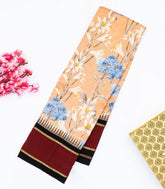-
Baby Pink Handloom Kanchipuram Korvai Silk Saree and Zari Buttas
This handwoven kanchipuram korvai silk saree is filled with zari buttas in baby pink body along with contrast lavender border and palluMRP:- ₹23,908
- ₹23,908
- Unit price
- per
-
Baby Pink Handloom Kanchipuram Korvai Silk Saree With Zari Buttas
This handwoven kanchipuram korvai silk saree is filled with zari buttas in baby pink body along with contrast purple border and palluMRP:- ₹24,768
- ₹24,768
- Unit price
- per
-
Green & Yellow Handloom Kanchipuram Korvai Silk Saree With Purple Border
This handwoven kanchipuram korvai silk saree is filled with stripes in yellow & green body along with contrast purple temple border and palluMRP:- ₹16,856
- ₹16,856
- Unit price
- per
-
Off White Handloom Kanchipuram Korvai Silk Saree With Checks
This handwoven kanchipuram korvai silk saree is filled with checks in off white body along with contrast temple border and palluMRP:- ₹21,844
- ₹21,844
- Unit price
- per
-
Bubble-gum Pink Handloom Kanchipuram Korvai Silk Saree With Zari Stripes
This handwoven kanchipuram korvai silk saree is filled with zari stripes in bubble-gum pink body along with contrast grey border and palluMRP:- ₹23,220
- ₹23,220
- Unit price
- per
-
Light Peach Handloom Kanchipuram Korvai Silk Saree With Zari Buttas
This handwoven kanchipuram korvai silk saree is filled with zari buttas in light peach body along with contrast pink border and palluMRP:- ₹25,112
- ₹25,112
- Unit price
- per
-
Cardamom Green Handloom Kanchipuram Korvai Silk Saree With Zari Buttas
This handwoven kanchipuram korvai silk saree is filled with zari buttas in cardamom green body along with contrast border and palluMRP:- ₹25,112
- ₹25,112
- Unit price
- per
-
Dusty Pink Handloom Kanchipuram Korvai Tissue Silk Saree With Floral Motifs
This handwoven kanchipuram korvai tissue silk saree is filled with floral motifs in dusty pink body along with contrast green zari border and palluMRP:- ₹47,968
- ₹47,968
- Unit price
- per
-
Cream Handloom Kanchipuram Korvai Tissue Silk Saree With Floral Motifs
This handwoven kanchipuram korvai tissue silk saree is filled with floral motifs in cream body along with contrast purple zari border and palluMRP:- ₹46,368
- ₹46,368
- Unit price
- per
-
Yellow Handloom Kanchipuram Korvai Silk Saree With Checks & Ganga Jamuna Border
This handwoven kanchipuram korvai silk saree is filled with checks in yellow body along with contrast ganga jamuna border and palluMRP:- ₹20,970
- ₹20,970
- Unit price
- per
-
Yellow Handloom Kanchipuram Korvai Silk Saree With Floral Motifs & Contrast Magenta Border
This handwoven kanchipuram korvai silk saree is filled with floral motifs in yellow body along with contrast magenta border and palluMRP:- ₹47,968
- ₹47,968
- Unit price
- per
-
Mustard Handloom Kanchipuram Vairaoosi Korvai Silk Saree With Buttas
This handwoven kanchipuram vairaoosi korvai silk saree is filled with buttas in mustard body along with peacock motifs in contrast purple border and palluMRP:- ₹38,970
- ₹38,970
- Unit price
- per
-
Black Handloom Kanchipuram Korvai Silk Saree Printed With Floral Motifs
This handwoven kanchipuram korvai silk saree is printed with floral motifs in black body along with contrast red temple border and palluMRP:- ₹14,700
- ₹14,700
- Unit price
- per
-
Light Peach Handloom Kanchipuram Korvai Silk Saree Printed With Floral Motifs
This handwoven kanchipuram korvai silk saree is printed with floral motifs in light peach body along with contrast black temple border and palluMRP:- ₹14,700
- ₹14,700
- Unit price
- per
-
Off White Handloom Kanchipuram Korvai Silk Saree Printed With Floral Motifs
This handwoven kanchipuram korvai silk saree is printed with floral motifs in off white body along with contrast black temple border and palluMRP:- ₹14,700
- ₹14,700
- Unit price
- per
Subscribe To Our Newsletter
Receive early access to new arrivals, sales, exclusive content, events and much more!
